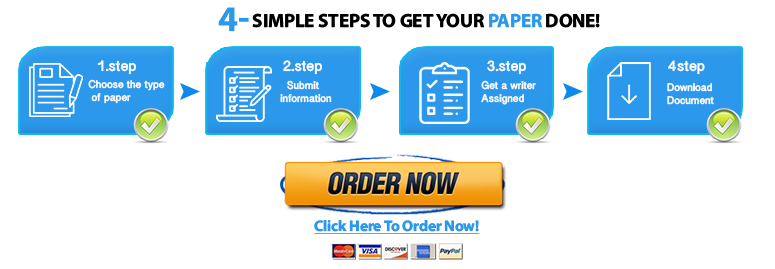Customer Motivation
Part1
Customer Motivation
Save your time - order a paper!
Get your paper written from scratch within the tight deadline. Our service is a reliable solution to all your troubles. Place an order on any task and we will take care of it. You won’t have to worry about the quality and deadlines
Order Paper NowMost large companies spend a substantial amount of money on creating advertising campaigns that influence customer behavior. Select the following link to review some memorable advertising campaigns: Top Company Ads.
Write 375–450 words that respond to the following questions with your thoughts, ideas, and comments. This will be the foundation for future discussions by your classmates. Be substantive and clear, and use examples to reinforce your ideas.
Complete the following for this assignment:
Search online for ads or commercials from your selected company. Provide a link of the ad in your discussion post.
Then, complete the following:
Give a brief sketch of the ad or commercial. Add the link or reference.
Describe 1 feature of the ad that makes it different from its competition.
What makes the ad persuasive and memorable?
Do you think this is an effective ad for your customer group? Why or why not?
Part 2
PowerPoint presentation of 6–8 content slides, with 150–200 words per slide
As a consultant for your product’s marketing team, you have been asked to discuss the purchasing decision process and customer motivations to buy. Click here http://search.ebscohost.com/login.aspx?direct=true&db=buh&AN=63294449&site=eds-live&scope=site to study the article, an examination of the effects of virtual experiential marketing on online customer intentions and loyalty. One model that advertisers often use to design targeted campaigns to specific customer groups is from Abraham Maslow’s hierarchy of needs theory. http://www.abraham-maslow.com/m_motivation/Hierarchy_of_Needs.asp Click here to learn more about his theory.
Create a PowerPoint presentation of 6–8 content slides that does the following:
- Slides 1–2: Describe the purchasing buying process.
- Slides 2–3: Explain Maslow’s hierarchy of needs theory.
- Slides 3–4: Apply Maslow’s hierarchy of needs theory to your suggested target market for your selected product.
- Slides 4–5: Use your 2 suggested advertising appeals from this week’s discussion to tie the product’s features back to your ad suggestions.
- Slides 5–6: Turn the product’s features into benefits for your customer.
- Slides 6–7: Draft 1 persuasion message of at least 50–100 words that can be used later in your advertising ideas for your Key Assignment. Remember to include a motivational appeal from Maslow. You can also use your BAV work to create the message.
- Slides 7–8: Write a conclusion explaining why the message matches your target market. Explain the message appeal using one need based on Maslow’s hierarchy of needs theory.
Possible reference and information that might help
http://www.consumersinternational.org/
The Consumer Purchase Process – What Motivates Us to Buy
Motivation is the force that prompts consumers to do something. Thirst usually
motivates a person to grab a soda from the refrigerator. Thirst, however, is a basic
motivating factor, while marketers try to uncover other forces that cause consumers to
act the way they do. Marketers also try to motivate him or her to purchase a particular
product.
A consumer may feel thirsty and buy a soda, or because he or she just saw a soda
commercial. How did the beverage get in the refrigerator in the first place? What
caused the shopper to buy it? Was it simply thirst, or was it to fulfill a higher need? For
example, was it because the consumer views the brand as a “cool” product his or her
friends drink while participating in activities the consumer enjoys? If thirst was the
only motivation, then why did the consumer choose this instead of water? Most likely,
the answer is because the company did an excellent job of marketing to the consumer
to motivate him or her to buy the product!
Maslow’s Hierarchy of Needs
Maslow’s Hierarchy of Needs is probably the best-known and most accepted
motivation theory. You can visualize the hierarchy as a pyramid, with the most basic
needs as the foundation and all other needs built upon these basic needs. First, it is
necessary to meet the basic needs, such as food, water, and shelter, and then an
individual seeks to fulfill other needs once these are satisfied.
Marketers are most interested in fulfilling the upper levels of the “pyramid”; the need
for belonging, status, and self-actualization. These needs are not as basic and are easier
to influence. If a person is very thirsty and just needs to quench his or her thirst, then
Anything wet will do. In most modern societies, however, it is easy to meet basic needs,
And people are seeking more. Marketers want to influence your choice of beverage,
Therefore, by having it meet another higher-level need, such as prestige.
How Consumers Learn
Consumers need to learn about products and services for them to be motivated to
purchase them. According to consumer behavior experts, there are two basic theories
on the ways consumers learn: the behavioral theory, which stipulates that consumers
learn by observation and by responding to stimuli in the environment; and the
cognitive theory, which states that consumers learn through a series of mental
processes.
Consumer Attitudes Help Drive Motivation
People learn and form attitudes through many complex factors. Family, friends,
culture, religion, and other important components of a person’s life help shape his or
her attitudes. Personality plays a major role in forming attitudes. For example, a more
https://campus.ctuonline.edu/courses/MKT325/p3/hub1/3299.pdf
Question 1: What is the consumer decision-making model?
Answer 1: There are three stages to the consumer decision-making model:
input, process, and output. The input stage involves external influences, such
as the company’s product, advertising, campaign venues, and price, as well
as the consumer being influenced by family, social class, culture, and
subculture. The process stage revolves around the consumer decision
making, in which the consumer considers needs, experience, and evaluation
of alternative products. The output stage involves postdecision issues, such
as the question of a repeat purchase. It is an interesting stage because the
results of this stage are used as experience for the process stage when
subsequent purchases are considered (Schiffman & Kanuk, 2004).
Question 2: What are some key differences between selling to consumers
and selling to businesses?
Answer 2: Consumers are the end users of a good or service. They are
evaluated by their demographics and market. Businesses, on the other hand,
may be of any of the following four types: producers, resellers, government,
and institutions. Producers purchase goods and services to enable them to
manufacture other goods or provide other services. Resellers are businesses
that purchase to resell either at a retail or wholesale level. Government
customers can be at a local, state, federal, or international level or a
combination thereof. Institutions are classified, for example, as schools,
hospitals, or churches. Selling to businesses requires the salesperson not only
to be aware of his or her customers but also of those customers’ customers.
There is an added dimension to the sale that requires a more in-depth look at
these customers to include not only their market and competition but also the
market and competition of the customers’ customers.
Question 3: What is Maslow’s hierarchy of needs?
Answer 3: Maslow’s hierarchy of needs ascends from the most basic needs
to a higher level of needs, as follows:
• Self-actualization (self-fulfillment)
• Ego needs (prestige, self-esteem)
• Social needs (affection, friendship)
• Safety and security needs (protection, order)
• Physiological needs (food, water, shelter)
Reference
Schiffman, L. G., & Kanuk, L. L. (2004). Consumer behavior. Upper Saddle
River, NJ: Prentice Hall.
"Looking for a Similar Assignment? Order now and Get 10% Discount! Use Code "Newclient"




